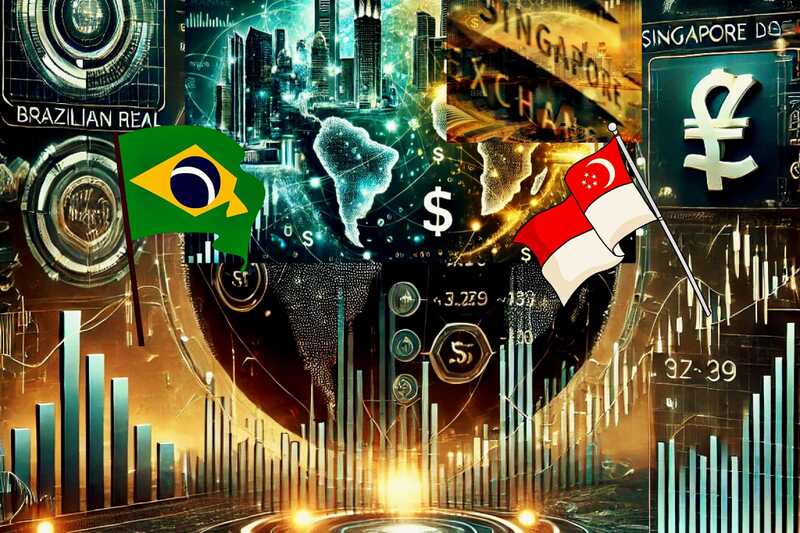 Introduction of trading of Brazilian futures in Singapore Stock Exchange. Image: AI generated/Pixabay
Introduction of trading of Brazilian futures in Singapore Stock Exchange. Image: AI generated/Pixabay
Sgx And B3 Alliance: Brazilian Real Futures Launch In Asia For Investors And Financial Markets
The Singapore Exchange (SGX) has announced a strategic partnership with Brazil’s B3 exchange to launch futures contracts in the Brazilian real later this year, subject to regulatory approval. These futures contracts represent SGX’s initial venture into emerging market currencies beyond Asia.
Significance of the SGX-B3 Alliance
This collaboration leverages Singapore’s status as a premier financial hub in Asia to provide investors with innovative tools for hedging currency risk in Latin America. SGX, a leader in Asia’s derivatives market, is expanding through its alliance with B3 to meet the demand for Latin American market access.
Brazilian Economy and International Trade Dynamics
Brazil is a key player in global commerce with major exports such as iron ore, soybeans, and crude oil. Increasing economic interdependence between Asia and Latin America underscores the need for reliable currency risk management solutions, particularly for firms involved in intercontinental trade.
Benefits of Brazilian Real Futures in Asia
This initiative brings several advantages, including enabling Asian investors to trade Brazilian real futures during their local trading hours and reducing reliance on U.S. and European markets. It also strengthens risk management for firms by providing tools to hedge currency volatility and enhance financial certainty.
Boosting Trade and Investment Between Asia and Brazil Trade flows between Singapore and Brazil, valued at approximately $4 billion annually, include imports like crude oil and agricultural products and exports such as refined petroleum and electronic components. The introduction of futures contracts will foster economic relations and facilitate investment flows.
Challenges in Implementation
The success of this initiative relies on securing regulatory approval in Brazil and Singapore, which may delay implementation. Liquidity and stability in the offerings will also play a critical role in market reception. Additionally, the volatility of the Brazilian real presents risks that investors must carefully consider.
Future Opportunities and Market Implications
If successful, this partnership could pave the way for SGX to introduce more emerging market currency futures. Expansion may include other Latin American or African currencies, and the move may encourage financial hubs like Hong Kong and Dubai to explore similar products, heightening competition in the derivatives market.
The SGX-B3 partnership is an ambitious effort to deepen financial ties between Asia and Latin America. While challenges exist, the potential benefits for investors, businesses, and global trade are substantial. Success could transform the trading of emerging market currencies and reinforce Singapore’s position as a world-class financial hub.
Significance of the SGX-B3 Alliance
This collaboration leverages Singapore’s status as a premier financial hub in Asia to provide investors with innovative tools for hedging currency risk in Latin America. SGX, a leader in Asia’s derivatives market, is expanding through its alliance with B3 to meet the demand for Latin American market access.
Brazilian Economy and International Trade Dynamics
Brazil is a key player in global commerce with major exports such as iron ore, soybeans, and crude oil. Increasing economic interdependence between Asia and Latin America underscores the need for reliable currency risk management solutions, particularly for firms involved in intercontinental trade.
Benefits of Brazilian Real Futures in Asia
This initiative brings several advantages, including enabling Asian investors to trade Brazilian real futures during their local trading hours and reducing reliance on U.S. and European markets. It also strengthens risk management for firms by providing tools to hedge currency volatility and enhance financial certainty.
Boosting Trade and Investment Between Asia and Brazil Trade flows between Singapore and Brazil, valued at approximately $4 billion annually, include imports like crude oil and agricultural products and exports such as refined petroleum and electronic components. The introduction of futures contracts will foster economic relations and facilitate investment flows.
Challenges in Implementation
The success of this initiative relies on securing regulatory approval in Brazil and Singapore, which may delay implementation. Liquidity and stability in the offerings will also play a critical role in market reception. Additionally, the volatility of the Brazilian real presents risks that investors must carefully consider.
Future Opportunities and Market Implications
If successful, this partnership could pave the way for SGX to introduce more emerging market currency futures. Expansion may include other Latin American or African currencies, and the move may encourage financial hubs like Hong Kong and Dubai to explore similar products, heightening competition in the derivatives market.
The SGX-B3 partnership is an ambitious effort to deepen financial ties between Asia and Latin America. While challenges exist, the potential benefits for investors, businesses, and global trade are substantial. Success could transform the trading of emerging market currencies and reinforce Singapore’s position as a world-class financial hub.
Senior Editor: Kenneth Njoroge
Financial Expert/Bsc. Commerce/CPA